An annual, rather peculiar, small to medium sized polypore. It is easier to recognize if you find it on its main host, Alder.
Home / Mushroom Guide /
Alder Bracket
Alder Bracket
| Mushroom Type | |
| Common Names |
Alder Bracket, Ysgwydd y Gwern (CY), Błyskoporek Promienisty (PL), Égerfa-Rozsdástapló (HU) |
| Scientific Name |
Xanthoporia radiata |
| Synonyms |
Mensularia radiata, Inonotus radiatus |
| Season Start |
Jul |
| Season End |
Nov |
| Average Mushroom height (CM) | |
| Average Cap width (CM) |
Please note that each and every mushroom you come across may vary in appearance to these photos.
Fruiting Body
Annual, sessile (growing without a stem), broadly attached to the host tree. 3–8 cm long, 2–5 cm wide, 1.5–2 cm thick, semi-circular; numerous fruit bodies often overlapping and (ef)fused.
Sterile (upper) surface finely hairy (tomentose) at first, but the fine hairs often flattened down to the surface (appressed) to the point when it feels almost smooth (glabrous). Once flattened, often concentrically zonate. Pale yellow brown to reddish brown, darkens to tobacco brown to almost black with age. Margin rounded, sometimes radially wrinkled.
Pores
Tubes 3–8 mm long, rusty brown to amber brown with a thin, silvery covering layer (pruina). Pores 2–4 per mm, round-angular to irregularly rounded, covered with tiny hairs (which only can be observed with a magnifying lens from a certain angle), silvery grey to yellowish, yellow brown, bruises darker rusty brown.
Flesh
Up to 1 cm thick, fairly zonate. Soft at first, then corky to woody, becoming fragile at the end. Yellowish brown at first, then turns dark brown.
Habitat
Almost always on dying or dead wood of Alder (Alnus), rarely on Birch (Betula) or other broadleaves. Necrotrophic parasite (some authors say saprotrophic on wood), causes white-rot.
Possible Confusion
It is hard to confuse with other species.
Oak Bracket (Pseudoinonotus dryadeus) might look similar for some, but it is a root parasitic species, mostly growing around the roots of an Oak (Quercus) or a Chestnut (Castanea). It is a common species and much larger than Alder Bracket.
Mensularia nodulosa, pictured, grows on Beech (Fagus), and it is really rarely recorded and has a NT – Near Threatened status on the Red Data List (2006).
Taste / Smell
Inedible. Smell and taste not distinctive.
Frequency
Widespread and common on the British Isles.
Spores
Spore print whitish to pale yellowish. Spores ellipsoid to almost spherical (subglobose), colourless (hyaline) to yellowish, thick-walled, smooth and dextrinoid (turning reddish-brown in Melzer’s reagent).
Other Facts
Like many current or former Inonotus species, Alder Bracket often guttates (secrets sticky droplets without any sort of cell damage). The droplets are translucent to pale amber at beginning, darkening with age and might leave some drop marks on the sterile upper surface.
The epithet (2nd part of the scientific name) ‘radiata‘ means ‘having radiating markings’.
It is more common in Northern Europe, much less frequent in the Mediterranean region. It is widespread and common in Northeastern, North Central and Southern regions of the US.


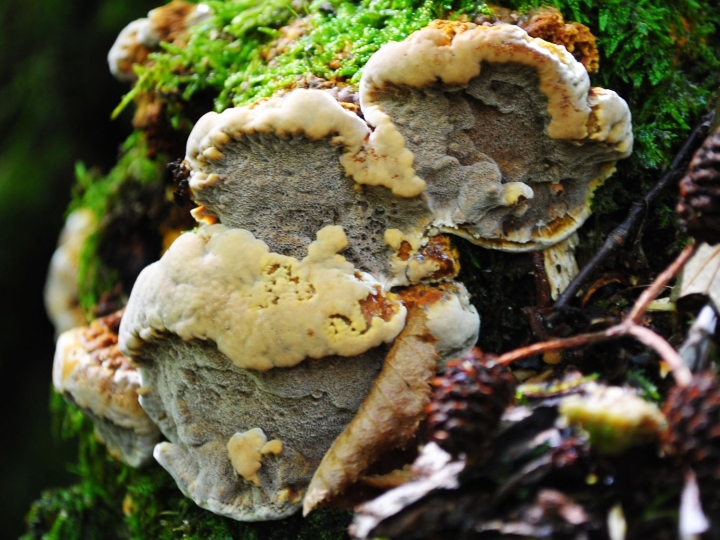
















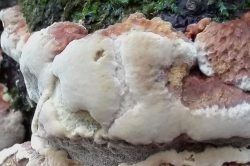
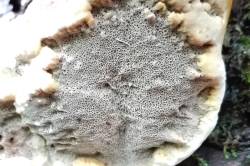
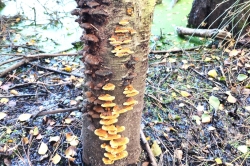
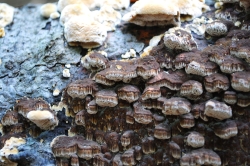
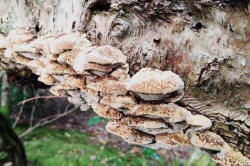






Leave a Reply